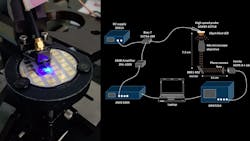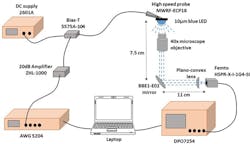Lab-Based “Li-Fi” Link Exceeds 7 Gb/s Using Blue Micro LED
This article appeared in Electronic Design and has been published here with permission.
As an optically based complement to RF-based Wi-Fi, Li-Fi (light fidelity) offers distinct attributes including potentially extremely high throughout over limited distances and immunity from (and non-sourcing of) EMI/RFI. One other characteristic of an optical link can be considered either a benefit or a drawback: Its line-of-sight path provides outstanding immunity to eavesdropping and hacking, but also limits user mobility.
Adoption of Li-Fi in the marketplace has been very limited thus far. However, there’s an industry association that provides standards and support, and there’s the potential for using a single LED bulb/photoreceptor unit as both light source and Li-Fi node (see Resources below).
Researchers, of course, see pushing the envelope of optical-based data links as an area of great interest. A team at Leti (a research institute of CEA Tech, Grenoble, France) has achieved a visible light communication (VLC) test-bed transmission at 7.7 Gb/s (significantly exceeding the previous 5.1-Gb/s record) using a single, 10-µm diameter, gallium-nitride (GaN) blue micro LED (Fig. 1). (In general, a smaller emissive area of the LED yields a higher bandwidth—here, 1.8 GHz in the institute’s single-blue micro LED project.)
In addition to the micro LED, the team also developed an advanced multi-carrier modulation scheme combined with digital signal processing to achieve their results. This high spectrum-efficiency waveform was transmitted by the single LED, received on a high-speed photodetector, and demodulated using a direct sampling oscilloscope (Fig. 2).
This class of experimental test bed requires many electro-optical components as well as test-and-measurement equipment for support, including these:
- Keithley (Tektronix) 2601 Current/voltage Source /DC Supply
- Mini-Circuits ZHL-1000-3W 3W, 500 to 1000 MHz Amplifier
- Tektronix AWG5204 Arbitrary Waveform Generator
- Microworld MWRF-ECP18 18-GHz RF probe
- Femto HSPR-X2 GHz Ultra-Fast Photoreceiver
- Thor Labs BBE1-E02 - 1" Broadband Dielectric Elliptical Mirror
- Tektronix 7254 Digital Oscilloscope
- Picosecond Pulse Labs (Tektronix) 5575A Bias Tee
While the Light Communications Alliance (created in 2019) is intended to encourage the industry to implement standardization and promote interoperability between Li-Fi systems from different manufacturers, CEA-Leti is planning to continue its research in two areas:
- Developing a better understanding of the electrical behavior of single LEDs in high-frequency regimes and the link between bandwidth and electromigration patterns.
- Investigating techniques to improve the range and/or increase the data rate using a matrix of multi-LED emissive devices. This requires adapting the waveform generation as well as a CMOS interposer to drive the matrix on a pixel basis.
LiFi Resources
About the Author

Bill Schweber
Contributing Editor
Bill Schweber is an electronics engineer who has written three textbooks on electronic communications systems, as well as hundreds of technical articles, opinion columns, and product features. In past roles, he worked as a technical website manager for multiple topic-specific sites for EE Times, as well as both the Executive Editor and Analog Editor at EDN.
At Analog Devices Inc., Bill was in marketing communications (public relations). As a result, he has been on both sides of the technical PR function, presenting company products, stories, and messages to the media and also as the recipient of these.
Prior to the MarCom role at Analog, Bill was associate editor of their respected technical journal and worked in their product marketing and applications engineering groups. Before those roles, he was at Instron Corp., doing hands-on analog- and power-circuit design and systems integration for materials-testing machine controls.
Bill has an MSEE (Univ. of Mass) and BSEE (Columbia Univ.), is a Registered Professional Engineer, and holds an Advanced Class amateur radio license. He has also planned, written, and presented online courses on a variety of engineering topics, including MOSFET basics, ADC selection, and driving LEDs.


